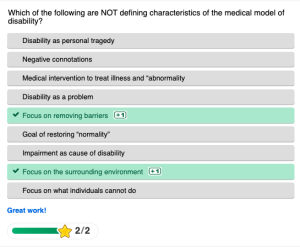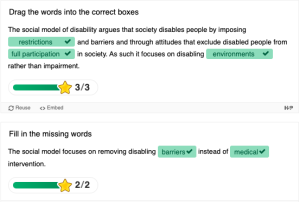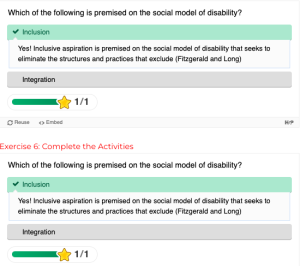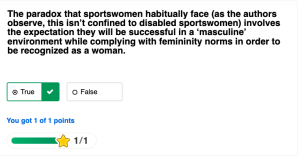5
Section one: The fundamentals
A)
Exercise 1: Notebook Prompt
Many of you are likely familiar with the concept of “ability inequity,” which the authors of this article define as “an unjust or unfair (a) ‘distribution of access to and protection from abilities generated through human interventions’ or (b) ‘judgment of abilities intrinsic to biological structures such as the human body’.”
However, they go on to identify the following “ability concepts” that are less familiar:
1) ability security (one is able to live a decent life with whatever set of abilities one has)
2) ability identity security (to be able to be at ease with ones abilities)
How prevalent are these forms of security among disabled people you know? Or, if you identify as a disabled person, would you say your social surroundings and community foster and support these kinds of security? Furthermore, while the focus of the article is on Kinesiology programs, it is also important to reflect on how academia in general accommodates for disability. If you feel comfortable answering this question, what has been your experience of postsecondary education to date?
-OR-
The authors also observe that “Ableism not only intersects with other forms of oppression, such as racism, sexism, ageism, and classism, but abilities are often used to justify such negative ‘isms’.”
What do you think this means? Provide an example.
| To me, this idea means that we tend to judge others based on what we perceive as the standard of abilities that each person should have. When we view someone as having the inability to do something that we see as a standard of life from our perspective, whether conscious or not, it opens the doors to throw more harsh judgments their way. I believe this could be an example of the contrast effect, where we “compare two [each other] instead of assessing each [other] on [our] merit” (Soken-Huberty, 2024). This type of bias allows us to ‘cut corners’ and categorize others based on a perceived idea of what a standard of abilities should be. Thus, this effect and ability perception opens the door to criticism. People may not fit into our ‘idea’ of what is acceptable, giving license to harsh judgments, and creating more sexist, racist, and classist ideals. An example of this would be in a job interview, where the interviewer compares two candidates, and rather than assessing them based on what they offer to the company based on the company’s standards, the interviewer assesses them compared to one another, forming their own standards based on the comparison. This could lead the interviewer to make assumptions that are based on the negative ‘isms’, causing the candidate who the interviewer perceives as more ‘able’ to be hired instead of the other, purely based on assumptions. This example illustrates our tendency to assess others based on what we think is acceptable surrounding our abilities, and failure to meet this criterion causes people to categorize and negatively associate them with one or more of the ‘isms’.
References Soken-Huberty, E. (2024, September 5). 10 examples of unconscious bias. Human Rights Careers. https://www.humanrightscareers.com/issues/examples-of-unconscious-bias/ |
Exercise 2: Implicit Bias Test
Did anything surprise you about the results of the test? Please share if you’re comfortable OR comment on the usefulness of these kinds of tests more generally.
| I think these tests are extremely useful. This is because a lot of our biases are either ingrained in us since birth or based on an isolated experience of others or even based on things we’ve seen on social media. These tests are important as they can help us identify our implicit biases and address them. I’m sure most people think they aren’t racist or sexist or possess any other prejudice, however, I believe most, if not all people hold some sort of negative view of at least one ‘group’ of people. If all people made an effort to identify our own negative viewpoints, we could make strides toward removing them from our minds and make our society that much more accepting and kind. |
B) Keywords
Exercise 3:
Add the keyword you contributed to padlet and briefly (50 words max) explain its importance to you.
| This term is important to me as I don’t feel it is as considered as the other issues that exist. While there is still much improvement needed, racist and sexist issues tend to have a lot of focus and strides for improvement, yet ableist issues are rarely considered.
|
B) On Disability
Exercise 4: Complete the Activities


Exercise 5: Notebook Prompt
What do Fitzgerald and Long identify as barriers to inclusion and how might these apply to sport in particular?
One of the barriers to inclusion identified within Chapter 10 by Fitzgerald and Long is structural barriers. An example of a structural barrier is a sports facility that lacks accessible services, such as a changing room or court. Another example of a structural barrier is the lack of accessible transportation. This may mean that these areas do not have proper ramps for those who are in wheelchairs, prohibiting them from entering such a facility. Attitudinal barriers are also mentioned within this chapter. This barrier consists of “behaviours, perceptions, and assumptions that discriminate against persons with disabilities” (COU, 2017). An example in sport of this barrier is the influence of negative stereotypes that are possessed by coaches or decision-makers. The idea that one with a disability may not be able to perform in comparison to others may cause the coach to cut them from the team or not let them participate based on their own assumptions and not merit. Coaches may make decisions that poorly impact those who have a disability based on “the negative connotations associated with disability tend to lead to negative views being associated with disabled people and the focus is often on what disabled people cannot do rather than what they can” (Long et al, 2017). Overall, each of these barriers “excludes disabled people from full participation in society, which together lead to their marginalization and oppression” (Long et al, 2017).
References
COU. (2017, May 29). Understanding barriers to accessibility. Accessible Campus. https://accessiblecampus.ca/understanding-accessibility/what-are-the-barriers/#:~:text=Attitudinal.%20Attitudinal%20barriers%20are%20behaviours%2C%20perceptions%20and,misconceptions%20about%20a%20person%20with%20a%20disability.
Long, J., Fletcher, T., & Watson, B. (Eds.). (2017). Sport, Leisure and Social Justice (1st ed.). Routledge. https://doi-org.proxy1.lib.trentu.ca/10.4324/9781315660356
C) Inclusion, Integration, Separation

Exercise 7: Notebook Prompt
Choose ONE of the three questions Fitzgerald and Long argue disability sport needs to address and record your thoughts in your Notebook.
- Should sport be grouped by ability or disability?
- Is sport for participation or competition?
- Should sport competitions be integrated?
| Is sport for participation or competition?
On a personal level, I think sports are too focused on competition and I think there should be a healthy combination of both participation and competition. I feel that the competitive aspect of sports often scares people and is a contributing factor in people’s disliking of sports. For example, when I was younger, we would play volleyball in gym class. Volleyball was my favourite sport, and I used to have a lot of fun playing it. To me, the game was just a fun way to escape the other stressors in my life, however, a lot of my classmates took the game too seriously. Gym class would often end with people arguing and yelling when all I wanted to do was play a fun and lighthearted game with my friends. This experience deterred me from playing volleyball in a league or club, or even at school as it became unenjoyable from the competitive aspect. I feel that I missed out on a lot of the health benefits of playing a sport, and I look back and wish there was something I could have joined that was just about people coming together to play something they all loved and having fun. I was prohibited by the competitive side of sports, thus missing out on participation. I believe there should be more opportunities for kids to be able to join a league or club that allows them to play their favourite sports without fear of judgment or losing because of their competitive peers. By having such outlets for kids, our society could see major changes in the mental and physical health of the growing generations. For example, participation in sports results in significantly lower anxiety and depression rates (Health, 2017). It builds self-esteem and assists in cognitive growth (Health, 2017). Participation in sports also reduces the risk of substance abuse and suicide and boosts overall life satisfaction (Health, 2017). Also, sports can increase physical health as well, as it leads to better bone health, and lower risk of cardio diseases, cancer, diabetes, and muscular issues (Health, 2017). The problem with too much competition in sports is that it deters people who would love to participate from playing, which means many children and people miss out on all the great health benefits of sports. Therefore, I believe that while competition is good, our society should invest in more participation-based clubs and leagues. References President’s Council on Sports, Fitness & Nutrition Science Board. (2017, September 17). Health. Benefits of Youth Sports . https://odphp.health.gov/sites/default/files/2020-09/YSS_Report_OnePager_2020-08-31_web.pdf
|
Part Two: Making Connections
A) Gender, Sport and Disability
Exercise 8: Complete the Activity
The paradox that sportswomen habitually face (as the authors observe, this isn’t confined to disabled sportswomen) involves the expectation they will be successful in a ‘masculine’ environment while complying with femininity norms in order to be recognized as a woman.
True or false?

B) Masculinity, Disability, and Murderball
Exercise 9: Notebook/Padlet Prompt
Watch the film, Murderball and respond to the question in the padlet below (you will have an opportunity to return to the film at the end of this module).
The authors of “Cripping Sport and Physical Activity: An Intersectional Approach to Gender and Disability” observe that the “gendered performance of the wheelchair rugby players can…be interpreted as a form of resistance to marginalized masculinity” (332) but also point out that it may reinforce “ableist norms of masculinity.” After viewing the film, which argument do you agree with?
a) Murderball celebrates a kind of resistance to marginalized masculinity
| I believe that Murderball both reinforces ableist norms of masculinity and also can be seen as a resistance to marginalized masculinity norms. The first example that comes to mind when considering how it reinforces masculinity norms is when one of the players, Joe, is yelling and is then asked by a female coach or representative to wait until the game is complete, and he tells her that is fine, but as she walks away, he calls her a derogatory term (Rubin & Shapiro, 2006, 8:30). This conveys the aggressive nature of the Murderball players, which are normative within masculine sports. The aggressive nature of the men reinforces such norms; however, this very same example challenges the view of those with disabilities. This is evident as the “athletes’ physical displays of aggression and hard hits on the court sharply contrast with an ableist perspective of disability” (Lindemann & Cherney, 2008). By acting in ways that are aggressive and harsh, the Murderball players are challenging the view that those who have disabilities are unable to act in a normative way. The game and players “contest stereotypical notions of disability while simultaneously accepting and reifying ableist values” (Lindemann & Cherney, 2008). Therefore, I do believe that both arguments are valid and prevalent.
References Lindemann, K., & Cherney, J. L. (2008). Communicating in and through “Murderball”: Masculinity and disability in Wheelchair Rugby. Western Journal of Communication, 72(2), 107–125. https://doi.org/10.1080/10570310802038382 Optimum Releasing. (2006). Murderball. United States.
|
Section Three: Taking a Shot
A) Resistance
B) Calling out Supercrip
Exercise 10: Mini Assignment (worth 5% in addition to the module grade)
1) Do you agree with the critique of the “supercrip” narrative in this video? Why or why not? Find an example of the “supercrip” Paralympian in the 2024 Paris Paralympics or Special Olympics coverage and explain how it works.
| I do agree with the critique of the “supercrip” narrative as it sets a tone that struggling with a disability is inherently wrong. The video sets a precedent that all people with disabilities can ‘overcome’ what they struggle with and become ‘superhuman,’ when this idea is just not progressive. The issue with the idea of “supercrip” is that it also shows those with disabilities excelling in able-bodied environments, which means they are still assessed and ranked based on their abilities to meet normative standards. This reflects the idea that people who have a disability should strive toward achieving normalcy and becoming some sort of inspiration, thus, reinforcing the idea that having a disability is something that is meant to be overcome. I also agree with Loeppky in the discussion that the “supercrip narrative also creates an assumption among non-disabled people that every disabled person they see in the street must be yearning to go to the Paralympics” (Loeppky, 2023). This is problematic as it puts false expectations on those who have disabilities. This creates another issue, as Loeppky mentions in the article, that the “paralympic is […] radically exclusionary to many with disabilities” (Loeppky, 2023), which removes the opportunity for change as people automictically assume that it is available to all. Sophie Pascoe is a Para-swimmer who lost one of her legs in an accident. She has since won several awards and medals in the Paralympic Games (Landells, 2025). Sophie became a “symptomatic of an ableist rehabilitation supercrip narrative that frames New Zealand sport […] as progressive and inclusive” (Falcous & Scott), however, this idea is critiqued similar to the supercrip as it memorializes an ideal type of disability within an athlete. Thus, the idea of the “supercrip” is somewhat problematic as it puts false expectations on those with disabilities and removes awareness of how exclusionary the Paralympics are.
References Falcous, M., & Scott, G. (2022). New Zealand’s princess of the pool: Post-ableism and the media narrativisation of Sophie Pascoe. International Review for the Sociology of Sport, 58(5), 889-907. https://doi.org/10.1177/10126902221135031 (Original work published 2023) Landells, S. (2025, January 29). Dame Sophie Pascoe DNZM #166. Paralympics New Zealand. https://paralympics.org.nz/paralympian/sophie-pascoe-paralympian-166/#:~:text=A%20below%20the%20knee%20amputee%20following%20a,her%20to%20join%20the%20QEII%20Swim%20Club.&text=Sophie%20was%20appointed%20a%20Dame%20in%20the,Year’s%20Honours%20for%20her%20services%20to%20swimming. Loeppky, J. (2023, June 13). Grappling with ableism in the para-sport movement. Rooted in Rights. https://rootedinrights.org/grappling-with-ableism-in-the-para-sport-movement/
|
2) Does the film Murderball play into the supercrip narrative in your opinion? How does gender inform supercrip (read this blog for some ideas)?
(300 words for each response)
| I do believe that superball does play into the “supercrip” narrative to a degree but not fully, however, it does reveal the special influence of ‘masculine’ traits on those with disabilities. This is because, as I mentioned earlier, the players come off as very aggressive, which fulfills the idea that their actions are more ‘acceptable’ based on normative gender stereotypes, as seen in the aggression present in normative male athletics. This shows how gender informs the “supercrip” as the men who are participating in the sport are acting the way that they believe is proper and necessary based on the belief of what it is to be ‘manly.’ Murderball feeds into the “supercrip” narrative as the film demonstrates the players doing something that is extraordinary and unexpected. An example of this is how the film doesn’t necessarily focus on the structural issues that prevent players from participating, but rather focuses on the abilities of those with disabilities, conveying how they are resilient and defying the odds of success. However, to contrast this, I do believe the film also challenges the “supercrip” narrative. Rather than basing the points system of the game on normative standards and measures, the players can earn points based on their abilities. This gives an even playing field for each player as the one who is most ‘able’ isn’t the only one who can excel. This challenges the “superscript” narrative as it removes the idea that each player’s disability isn’t something to overcome or defy, but rather, success can be based on strategy and teamwork. Murderball does a good job of combining skill and strategy to remove the normative standards that can be arbitrary and unfair even when playing against others who have disabilities. Therefore, I believe Murderball plays into the “supercrip” narrative but also challenges it. |


